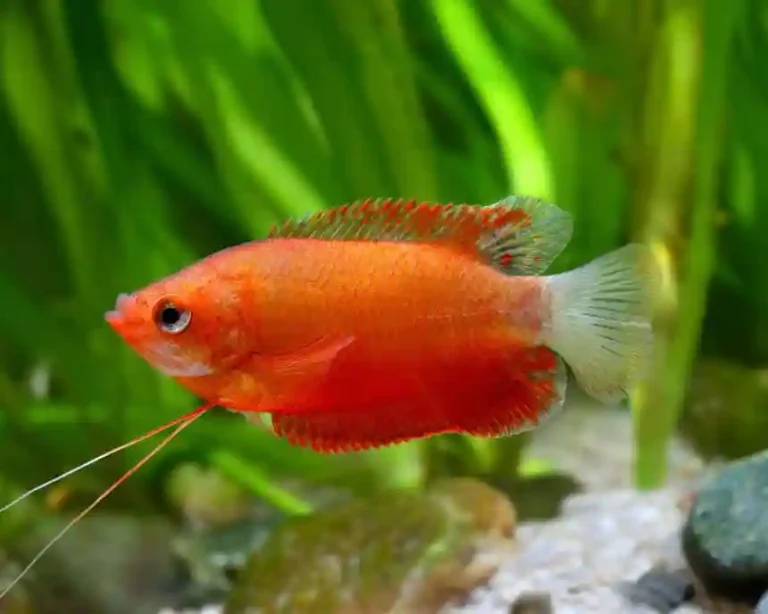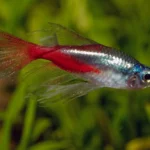Tiger Barbs (Puntigrus tetrazona) are among the most popular freshwater fish thanks to their striking black stripes, orange fins, and energetic nature. While they’re a favorite for community tanks, their reputation for fin-nipping and aggression can be challenging for beginner fishkeepers. With proper care, Tiger Barbs can live 5–7 years and grow up to 3 inches long. In this guide, we’ll cover everything you need to know: tank setup, diet, tank mates, aggression management, breeding tips, and more.
Quick Species Profile
| Feature | Details |
| Scientific Name | Puntigrus tetrazona |
| Size | 2.5–3 inches |
| Lifespan | 5–7 years |
| Temperament | Semi-aggressive, active |
| Tank Size | Minimum 20 gallons |
| School Size | 6+ recommended |
| pH | 6.0–7.5 |
| Temperature | 74–79°F (23–26°C) |

Tiger Barb Appearance & Behavior
Tiger Barbs are easily identified by their bold black stripes on a silver or gold body and vibrant orange or red fins. They are highly active swimmers and love to explore every part of the tank. These fish are social but can be notorious fin-nippers, especially when kept in small groups. A proper school of six or more helps spread out their energy and reduce unwanted aggression toward other fish.
Ideal Tiger Barb Tank Setup
Tank Size & Layout
A 20-gallon tank is the absolute minimum for a small school of Tiger Barbs, but larger tanks (30+ gallons) are better. These fish need open swimming areas as well as plants, rocks, or driftwood to break sightlines and reduce stress. Dense planting at the edges with open central space works well.
Water Conditions
Tiger Barbs thrive in slightly acidic to neutral water with a pH of 6.0–7.5. Keep the temperature between 74–79°F (23–26°C). Consistent water changes and stable parameters are key to their health, as fluctuations can trigger stress and illness.
Filtration & Flow
They appreciate moderate water flow and a well-oxygenated environment. Use a reliable filter that can handle their bioload and keep the water clean.

Tiger Barb Diet & Feeding
Tiger Barbs are omnivores, and variety is essential for their color and health. A balanced diet includes:
- High-quality flakes or micro-pellets
- Frozen or live foods like brine shrimp, bloodworms, and daphnia
- Blanched vegetables such as spinach or zucchini
Feed them twice a day in small portions they can consume in 2–3 minutes to prevent overfeeding and water pollution.
Tiger Barb Aggression & How to Manage It
Tiger Barbs can show fin-nipping behavior, especially in small groups where a hierarchy isn’t well established. To reduce aggression:
- Keep at least six Tiger Barbs (more is better — they spread out their energy)
- Provide a large enough tank with open space and decor
- Avoid slow, long-finned tank mates like Bettas or Guppies
- Feed a varied diet to prevent boredom
Creating a dynamic, active environment helps them stay busy and less focused on other fish.
Best Tank Mates for Tiger Barbs
The best tank mates are species that are fast, active, and can hold their own in a busy tank. Good options include:
- Zebra Danios
- Rosy Barbs
- Yo-Yo Loaches
- Black Skirt Tetras
- Giant Danios
Avoid slow-moving or long-finned fish (like Bettas, Guppies, or Angelfish) that may become targets for nipping.
Breeding Tiger Barbs in the Aquarium
Tiger Barbs are egg scatterers that breed readily under the right conditions. Set up a separate breeding tank (10–15 gallons) with marbles or mesh at the bottom to protect the eggs.
- Keep pairs or small groups well-conditioned with high-protein foods
- Raise the temperature slightly (78–80°F)
- Once eggs are laid, remove the adults to prevent them from eating the eggs
- Eggs hatch in 2–3 days; feed fry with infusoria or liquid fry food
Common Health Issues & Prevention
Tiger Barbs are generally hardy but can suffer from:
- Ich (white spot disease) — caused by poor water conditions or sudden temperature changes
- Fin rot — linked to stress and dirty water
- Fungal infections
Prevention is key: maintain good water quality, quarantine new fish, and provide a balanced diet.
Freshwater Fish Diseases: Symptoms, Causes & Treatment Guide
FAQs
Do Tiger Barbs need to be in groups?
Yes. They are a schooling species and should be kept in groups of at least six to reduce stress and aggression.
Why are my Tiger Barbs nipping other fish?
This usually happens in small groups or when kept with slow-moving tank mates. A larger school helps spread aggression.
How long do Tiger Barbs live?
With proper care, Tiger Barbs typically live 5–7 years in a home aquarium.
Can I keep Tiger Barbs with shrimp?
It’s risky. Tiger Barbs may harass or eat small shrimp. Stick with robust tank mates.
Final Thoughts
Tiger Barbs are beautiful, energetic fish that can be a joy to keep when given the right environment. Their care is straightforward if you provide a large enough tank, keep them in proper schools, and choose suitable tank mates. By understanding their behavior and meeting their needs, you can enjoy a lively and colorful community aquarium.








